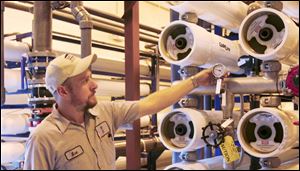
Delta water-treatment plant now open, ready for visitors
9/27/2006
Scott Johnston checks out flow reverse osmosis at the new water treatment plant in Delta.
DELTA - The village's long-awaited new water-treatment plant, which started supplying the village almost two weeks ago, is a sight to see, according to water-department workers who say they're eager to give tours.
"Walk around and see what you're paying for," said Scot Johnston, a water-plant operator. "We're really excited about this."
The new plant uses a remarkably different process than the old plant, which has used many of the same procedures since it opened in 1930.
Microfiltration is the first part of the new plant's two-step process. It has thousands of what look like miniature, synthetic straws that have tiny holes in them. When water is forced through those straws, impurities go one direction and water goes another.
That process does not remove the hardness from water, however. So, the new plant puts about half of its water through a process called reverse osmosis that operators say strips away almost everything, leaving little more than the combination of two hydrogen and one oxygen molecules.
Only half of the treatment plant's water goes through reverse osmosis in part because it takes away so much that it also could affect the taste of water. The water that goes through reverse osmosis is then blended with water that went through microfiltration only.
It's a far cry from the process at the old water plant, which treated water from Bad Creek with chemicals.
Those chemicals bonded with impurities in the water and made what Mr. Johnston describes as a "snowflake." Water was agitated and then run through a settling basin in a process that took two to four hours and allowed the snowflakes of impurities to settle out.
From there, water went though a sand filter, made of 3 to 4 feet of sand as well as layers of pebbles and even golf ball-size rocks.
At the end, plant operators added chlorine and fluoride.
Individual students working on science projects sometimes toured the old plant. But operators are hoping whole classes as well as families, clubs, and other groups come to see the new plant, which cost about $6 million. Interest payments at 4.1 percent over 30 years will add about $4 million more.
Mr. Johnston promises tours that can be as short as 15 minutes or as long as two hours.
Although plants using microfiltration and reverse osmosis are popular on the West Coast and in Europe, they are rare locally.
"Delta, I hope, is on the cutting edge here," he said.
And after numerous set-up and political delays - the plant opened about $2 million over early budget estimates and about five months behind the last scheduled date for completion - plant workers are ready to show the community what it can do.
"If we would get thousands of people through here, I'd be tickled pink," Mr. Johnston said.